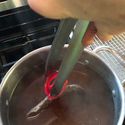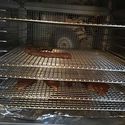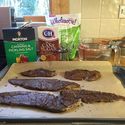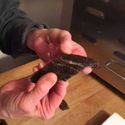Preserving summer's bounty: Make your own jerky
October 1, 2017
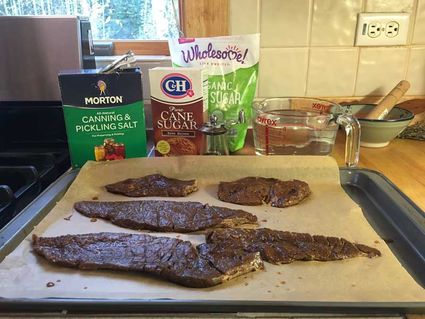
Leslie Shallcross photo
Jerky has undergone a revival as a snack and, now, health food. Making your own is a good way to put away some of your fish or game meat.
Not very many years ago high-carbohydrate bars were the "go-to" for hikers and other athletes. Now, when I pick up snacks for the trail, the shelves are loaded with pemmican-like meat snacks or meat jerky. Marketing statistics show meat snack sales increases of more than 45 percent between 2011 and 2017, with jerky second in popularity to potato chips in the "salty foods" category. In the past year alone, beef jerky sales have risen 7 percent, according to the National Cattlemen's Beef Association. Who would have thought that salty, dried meat would assume the cachet of a low-carb, high-protein health food?
I happen to enjoy jerky and I'm nearly convinced that a higher protein intake is beneficial. But, just how healthy is jerky? Jerky is made with very lean whole cuts or ground meat from beef, bison, poultry, wild game or fish. So, it fits the bill if you are looking for low-fat and low cholesterol. Jerky is a relatively low-calorie and high-protein food with about 70 to 80 calories per ounce serving and 10 to 12 grams of protein. For comparison, one egg provides about 70 calories and 6 grams of protein. The only real downside to most jerkies is the hefty dose of salt or sodium that comes with less than one fourth of your daily protein requirement. The salt content often ranges from one third to one half the recommended daily limit. Jerky may also be seasoned with sugar or some other sweetener contributing about one teaspoon of sugar in the average packaged jerky.
Dehydration and sanitation
If you had a successful harvest of deer, moose, caribou, bear or other game, freezing and canning have probably filled your freezer and pantry. But, drying or making jerky may be another way to keep your Alaska wild harvest. After all, one of my friends said, "it's easy - don't you just salt the meat and hang it over the wood stove to dry"?
In the past, dehydrating was accomplished with only the help of the wind, sun or fire. Current food science research cautions that these are not enough to make a safe dried meat product, especially when using wild game. Escherichia coli, salmonella and trichinella worms may all be found in jerky and a number of outbreaks of food poisoning have been traced to consumption of homemade jerky.
The USDA Food Safety and Inspection Service and the Cooperative Extension Service have researched and published methods that should be followed to create a safe product at home. Most importantly these methods include sufficient heating and careful handling to limit contamination before and after heating. Because the parasite trichinella nativa found in Alaska bears is not destroyed by freezing and may be difficult to destroy with heat, Alaska bear meat is not recommended for jerky.
Salting and drying do help to limit and reduce dangerous microorganisms but heating your product to the correct internal temperature for a sufficient period is a crucial step for making safe jerky. For making jerky at home, you will need an accurate food thermometer, an oven thermometer, a clean dehydrator (with a thermostat and a fan) that can attain and maintain sufficient heat during the drying process and/or an oven that can be operated at a low enough temperature. The dehydrator or the oven must be able to maintain a temperature of 145° F to 155° F. This temperature range is sufficient to keep pre-treated meat safe and prevent the meat from drying out too quickly on the surface.
How to make it
There are three researched methods for making safe jerky, although only one of these is recommended for game meat and only one is recommended by the USDA Food Safety and Inspection Service (no, you can't just hang it over the wood stove).
• heating in an oven to a higher temperature after drying
• precooking to a higher temperature before drying
• soaking in vinegar – cannot be used for game meat or ground meat
The safest way to make any jerky is to precook the meat, poultry, fish or game either in an oven or in brine and dry it afterward. The USDA Food Safety and Inspection Service recommends this exclusively as they have found that some microorganisms will become resistant to heat during the drying process and heating the jerky after drying may not destroy these heat resistant pathogenic microorganisms.
Precooking can be done by placing seasoned formed ground meat strips or seasoned whole meat strips in the oven or it may be done using a hot brine solution. The goal with either of these methods is to heat the beef, rabbit, fish or game meat to a safe internal temperature of 160° F or 165° F for poultry. The strips are then placed in a dehydrator or oven preheated to 145° F to 150° F to continue drying. Precooked jerky requires significantly less drying time than jerky that is heated afterward or that has been vinegar soaked.
The precooking method produces jerky that is more tender and perhaps dryer than commercial jerky. The surface color of the jerky tends to be somewhat dull versus shiny. But, my experiment with the precook method for moose jerky this year yielded an entirely delicious product even though it did not look quite as I expected.
After drying your jerky sufficiently, remove the jerky from the oven or dehydrator and allow to cool. You will know when the pieces are dry enough because they will bend and crack but not break. Place them into a container with a lid for "conditioning" - this allows moisture to be evenly distributed throughout the pieces. If moisture beads up on the lid, you may need to put the jerky back into the oven or dehydrator (take extreme care not to contaminate your product at this stage). Store your conditioned jerky in airtight containers. For long term storage keep in the refrigerator or freezer.
Is it done?
• Jerky is done when a test piece cracks but does not break when it is bent.
• Jerky should be dried a minimum of 6 hours for safety.
• 1 pound of meat will give approximately 4 ounces of jerky
• Remove jerky strips from the racks. Pat off any beads of oil with absorbent toweling. Cool.
• Package in glass jars or heavy plastic bags.
• Refrigerate or freeze the dried jerky.
• Dried jerky takes up moisture readily. Even if you dry jerky enough to prevent growth of microorganisms, over time, the meat could take up enough moisture to allow microorganisms to grow again. So keep the jerky cold for long term storage.
More jerky facts
Links and downloads for further information on jerky:
• http://extension.oregonstate.edu/fch/sites/default/files/documents/pnw_632_makingjerkyathome.pdf
• https://www.uaf.edu/files/ces/publications-db/catalog/hec/FNH-00262.pdf

Leslie Shallcross photo
Homemade jerky may have a different appearance, particularly the color, than store bought.
For more information about making jerky safely at home or about this article, contact Leslie Shallcross with the University of Alaska Fairbanks Cooperative Extension Service Tanana District at 907-474-2426 or lashallcross@alaska.edu.
Leslie Shallcross is a registered dietitian and associate professor at the University of Alaska Fairbanks School of Natural Resources and Extension.









